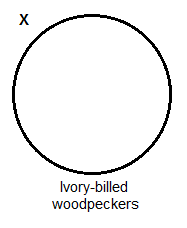Previous Month | RSS/XML | Current | Next Month
June 30th, 2016 (Permalink)
The Gang of Four Puzzle
The notorious gangster Victor Timm has been murdered. From the crime scene evidence, the police have determined that there was only one shooter. In addition, they have established that only four suspects had the means, motive, and opportunity to kill Timm: members of a rival gang known as the Gang of Four. Each of these suspects was brought in for questioning, and each made only two statements before lawyering up. Here are those statements; the names have been redacted to protect the innocent:
Mr. W: I didn't shoot Vic Timm. Mr. X let him have it.
Mr. X: I'm innocent. I don't even own a gun.
Mr. Y: I didn't kill Timm. Either Mr. W or Mr. Z did it.
Mr. Z: I didn't do it. Mr. X owns a gun.
The police have also determined that exactly half of the statements made by the four gangsters were true and half false, that is, there were four true statements made and four false ones. However, as usual, the police need your help: assuming that they are correct that one and only one of the Gang of Four killed Timm, and that half of the statements are true and half false, who done it? Can you help them solve the murder?
June 22nd, 2016 (Permalink)
Lesson in Logic 11: Class Diagrams
While researching the entry from last month on Hillary Clinton's Venn diagram―see Resource 1, below―I spent some time searching the web for a short, accurate, and easily understood introduction to Venn diagrams for those who, like Clinton, might not know how to read them. Unfortunately, I couldn't find anything that satisfied all three desiderata. The possibilities were either too technical―assuming, for instance, that the reader already knows set theory notation, in which case the reader probably also already knows how to read Venn diagrams―or were encyclopedic histories with more than you need to know to use them. Of course, most introductory textbooks on logic include sections explaining such diagrams, but you shouldn't have to buy a textbook for this limited purpose―though see Resource 4, below, if you want to become an expert.
For these reasons, I decided to write a few short lessons on how to understand and use Venn diagrams, of which this is the first. It's numbered 11 because I'm treating it as a continuation of the ten lessons on logic I wrote on this weblog several years ago. However, I expect that this and the subsequent lessons will stand on their own, so that you needn't read the previous ones―though I recommend it! Hopefully, candidate Clinton will study these lessons before "tweeting" any more embarrassing diagrams.
So, if you're ready, let's get started:
A class―also called a set, collection, or category―is a type of thing.
Examples of classes: Shoes, ships, cabbages, kings
It's important to note that classes need not have members. When a class has no members it is called an "empty" class.
Examples of empty classes: Unicorns, vampires, werewolves, passenger pigeons
Also, there are classes that have only one member. For instance, while the class of passenger pigeons is now empty, at one time there was a last surviving passenger pigeon named "Martha", so at that time the class of passenger pigeons had only one member. A more familiar example is the class of Presidents of the United States: at any given time, it has only one member.
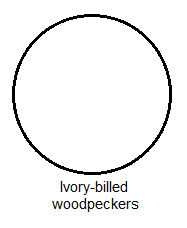
In both Euler and Venn diagrams, circles are used to represent classes. The idea is to imagine that all members of the class are inside the circle, and that everything that does not belong to it is outside the circle. As an example, let's create a circle to represent the class of ivory-billed woodpeckers, which you should see to the right. I choose this class because the ivory-billed woodpecker may be as extinct as the passenger pigeon, but we don't know for sure. Some people claim to have seen them in recent years―the woodpeckers, that is, not the pigeons―but it's possible they were mistaking members of the non-extinct species of pileated woodpeckers for the similar ivory-billed ones.
This illustrates an important point about class circles, namely, that the circle itself says nothing about whether there are or aren't members of the class. In fact, the circle itself says nothing at all; it's like the words "ivory-billed woodpeckers", which taken alone tell us nothing at all about ivory-billed woodpeckers. If someone simply said "ivory-billed woodpeckers" out of the blue, you might ask: "What about them?" for that person has so far told you nothing.
Here's a question for you:
Q: Where on the diagram are you?
A: You may be surprised to find out that you're on the diagram at all! You're not inside the circle, surely, for you're not a woodpecker, let alone an ivory-billed one. Keep in mind that the inside of the circle is for ivory-billed woodpeckers and only ivory-billed woodpeckers. So, everything else in the universe, including you and me and the world's tallest tree, is outside of the circle.
There's a word for everything outside the class circle, namely, the complement of the class. The complement of a class is the class of everything that is not in the class it complements (not "compliments"!) Now, you might wonder if this is really a class, since you, me, and the world's tallest tree, et cetera, don't seem to have anything in common. However, we do have one thing in common: none of us is an ivory-billed woodpecker! So, the complement of the class of ivory-billed woodpeckers is, indeed, a class.
Up to this point, what I've written applies to both Euler and Venn diagrams: both use circles to represent classes, which is one reason why it is easy to confuse the two. How they differ is in the way that the circles are used to say things about the classes. From this point on in this lesson, I will be explaining the symbolism used to say something about a single class in Venn diagrams. With Euler diagrams, you really can't say anything about a class with a single circle.
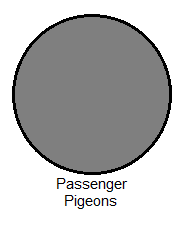
Let's start by creating a circle to represent the extinct passenger pigeon. How do we represent the fact that this class has no members? Simple: we shade in the circle as shown. This shows that there is nothing inside the circle, so that the class of passenger pigeons is an empty class. For the first time, our diagram actually says something, namely, that the class of passenger pigeons has no members. Translated into English, the diagram says: "There are no passenger pigeons" or "Passenger pigeons do not exist." In terms of the previous lessons, the diagram makes a statement―see Lesson 2, below.
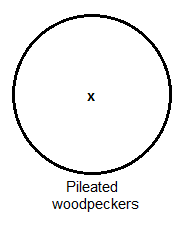
Q: How would you represent the class of pileated woodpeckers?
A: Simply draw a circle and label it: "pileated woodpeckers".
Q: How would you use the diagram to represent the fact that there are pileated woodpeckers?
A: Place an "X" in the class to indicate that there's something in there. You can think of the "X" as representing a particular woodpecker: "X marks the spot."
At this point, you may wonder how we can show that there is more than one such woodpecker.
Q: Would we show that there are two woodpeckers by putting two "X"s in the circle?
A: No, the "X" simply means that the class is non-empty; it says nothing about how many members it has. So, in English, the diagram says: "There are pileated woodpeckers" or "Pileated woodpeckers exist."
That's all that we can do with a single circle. Simple, isn't it? In the next lesson, we will add an additional circle, and things will get twice as complicated!
Exercises: Test your understanding of class circles and the two ways of expressing statements about classes by trying the following exercises. Each will push your understanding a little beyond what is explained above, so put on your thinking cap!
- Using the circle for the class of ivory-billed woodpeckers, above, how would you represent the statement that there are things that are not ivory-billed woodpeckers?
- For this exercise, start by drawing a circle to represent the class of material things. Suppose that you wanted to use the diagram to represent the philosophy of materialism, which claims that nothing is immaterial. Putting aside whether it is true or not, how would you represent the materialist's claim?
- Again, use the circle for the class of ivory-billed woodpeckers to represent the statement that not everything is an ivory-billed woodpecker.
- Again, draw a circle for the class of material things, and then represent the philosophy of idealism, which claims that nothing is material.
- Now, if you draw a circle representing the class of immaterial things, how would you represent the philosophy of idealism?
- In addition to claiming that nothing is immaterial, materialism also claims that there are material things. How would you alter the diagram you drew for exercise 2, above, to represent this additional claim?
- Looking at the diagrams from exercises 4 and 6, what can you conclude about the logical relationship between idealism and materialism?
Resources:
- Hillary Clinton's Scandalous Venn Diagram, 5/22/2016
- A. W. F. Edwards, Cogwheels of the Mind: The Story of Venn Diagrams (2004). Everything you want to know about Venn diagrams, and more!
- Sun-Joo Shin, Oliver Lemon & John Mumma, "Venn Diagrams", Stanford Encyclopedia of Philosophy, 2013. An advanced historical discussion.
- Thomas Schwartz, The Art of Logical Reasoning (1980). An interesting and unusual introduction to logic that uses Venn diagrams as the sole evaluative tool. This is the first edition, and there does not appear to have been another, so it doesn't seem to have caught on with instructors.
Previous Lessons: 1, 2, 3, 4, 5, 6, 7, 8, 9, 10
June 18th, 2016 (Permalink)
New Book: Truth or Truthiness
Howard Wainer has a book out called Truth or Truthiness: Distinguishing Fact from Fiction by Learning to Think Like a Data Scientist. I haven't read it yet, but I have read his earlier one, Visual Revelations, on the graphical display of information. Like Caesar's Gaul, the new book is divided into three parts: the first on how to think like a "data scientist"―which I think just means "statistician"―the second on using charts and graphs to communicate data, and the third applies the tools for thinking from the first part to the problems of reforming the schools and education. I can't promise but I may have a review later this year.
Resource: Charts & Graphs: The YY Graph, 11/19/2013
June 2nd, 2016 (Permalink)
The Cutting Room Floor
Katie Couric has gotten into some hot water for the misleading editing of a documentary she produced:
Couric acknowledged Monday night…that a documentary she produced and narrated, "Under the Gun," misrepresented her exchange with members of the Virginia Citizens Defense League [VCDL]. The film was edited in a way that added an artificial pause between one of Couric's questions and group members' response, which had the effect of making the interview subjects appear stumped. In reality, they answered right away.
Source: Callum Borchers, "Why Katie Couricís 'misleading' editing matters in the presidential campaign", The Washington Post, 5/31/2016
Misleading film and video editing are not the sort of thing that have logical fallacies named after them, but perhaps they should. It's very easy to make an interview subject look foolish through editing. This is nothing new, at least in certain quarters, but it's something that you should always keep in mind when watching documentaries or interview shows, especially those that walk the fine line between comedy and news. According to Megan McArdle, this at least used to be a standard practice on The Daily Show:
Seriously, don't go on "The Daily Show." They control the format, the questions and the editing process. There is no way you can win. Your purpose is to look like an idiot on the show, and they have all the tools they need to make sure you fulfill that purpose. There is a reason that you have never seen a video clip of someone who "beat" Jon Stewart…: They are really good at this, and what they are good at is making you look like a stubborn moron who couldn't find his backside with both hands in the dark.
Source: Megan McArdle, "Don't Ever Appear on 'The Daily Show'", Bloomberg, 9/23/2014
McArdle goes on to recommend what to do if you do go on the show:
If you must, bring two tape recorders, a video camera and a witness. Announce at the beginning that you are going to record this and reserve the right to release the entire recording to the public. When they tell you that they will not do the interview under those conditions, prepare to leave. There is no ethical reason that a reporter requires the ability to ask you questions without having those questions recorded. The reason they don't want unedited audio is that you might release it and be revealed as a normal decent person, rather than a horrible fool.
Interestingly, this is what the VCDL did―well, I don't know whether they followed McArdle's advice to the letter, or whether they had even read McArdle's article, but what they did do was to make an audio recording of the interview themselves. So, by releasing the recording of the full interview they established that there was no long pause after the question, eventually forcing Couric to apologize.
Michael Moore practically made his reputation through misleading editing, starting with his very first movie Roger & Me. However, his own movie about guns, Bowling for Columbine, had a particularly egregious example:
In Bowling for Columbine, Moore has refined the technique of deceptive editing that he developed in Roger & Me. He cuts and edits short snippets from two different speeches given by Charlton Heston more than a year apart, and presents them in such a way that the viewer assumes they are part of the same speech―one given at Denver just days after the Columbine massacre. By using cutaway edits to distract from Heston's apparent mid-speech change of clothes, Moore suggests that Heston is a callous fool who doesn't care or doesn't realize that the people of Denver and its suburbs have just been traumatized by a terrible crime. So we see Heston saying, in the first speech, which was given at Charlotte, North Carolina, more than a year after the Columbine killings: "…from my cold, dead hands!" while brandishing a rifle over his head. …In a rebuttal to his critics, Moore ackowledges the proximity of the edited images but not the possibility that they were meant to be perceived as part of the same speech. For anyone who has seen the film, this is rather disingenuous. Moore's voice-over narration says, "Just ten days after the Columbine killings, despite the pleas of a community in mourning, Charlton Heston came to Denver and held a large pro-gun rally for the National Rifle Association" while the "cold, dead hands" scene is still playing, while Heston is still holding the rifle over his head. The viewer, cued by the voice-over, would have a hard time not thinking this took place right after Columbine. I certainly thought so when I saw the movie for the first time.
Source: Jesse Larner, Forgive Us Our Spins: Michael Moore and the Future of the Left (2006), pp. 107-108
Indeed, and no doubt many people who saw the movie still believe that Charlton Heston went to Columbine right after the shootings and waved a rifle over his head while saying: "From my cold, dead hands!" If Moore didn't realize that the editing of the movie would have this effect then he's not as savvy a filmmaker as I think he is.
Now, Couric is supposed to be a serious journalist, unlike Moore or The Daily Show. The latter can always plead that they are comedians, not reporters, and what they do is entertainment rather than journalism. For example, when Moore appeared on CNN's Moneyline show to promote his book Stupid White Men, host Lou Dobbs pressed him about inaccuracies in it:
Dobbs: Salon.com just took you to task on this book, pointing out glaring inaccuracies….Moore: …[Y]ou know, look, this is a book of political humor. So, I mean, I don't respond to that sort of stuff, you know.
Dobbs: Glaring inaccuracies?
Moore: No, I don't. Why should I? How can there be inaccuracy in comedy?
Source: "Suicide Bomber Kills Six in Middle East; Venezuelan President Ousted", CNN, 4/12/2002
Similarly, in Jon Stewart's notorious appearance on CNN's Crossfire during which he criticized the show, Tucker Carlson tu quoqued him by bringing up Stewart's softball questioning on his own show of presidential candidate John Kerry:
Stewart: If you want to compare your show to a comedy show, you're more than welcome to. … I wouldn't aim for us. I'd aim for "Seinfeld." That's a very good show. …Carlson: You have a chance to interview the Democratic nominee. You asked him questions such as, quote, "How are you holding up? Is it hard not to take the attacks personally?" "Have you ever flip-flopped?" et cetera, et cetera. …
Stewart: You know, it's interesting to hear you talk about my responsibility. … I didn't realize that, and maybe this explains quite a bit, is that the news organizations look to Comedy Central for their cues on integrity. … But my point is this. If your idea of confronting me is that I don't ask hard-hitting enough news questions, we're in bad shape, fellows.
Source: "Jon Stewart's America", CNN, 10/15/2004
The traditional logical fallacies were developed over the centuries before the invention of movies and video, when spoken and written language were the dominant forms of communication. So, deceptive editing of video does not fit precisely in any existing category of fallacy. However, the kind of editing committed in the above examples is similar to―and in some cases actually is―quoting out of context, in that editing removes a clip from its context. In addition to removing it from its actual context, editing also places it in a different context, giving the clip a different significance. For example, by deceptive editing, the Heston "cold, dead hands" speech was made to appear to have occurred in a different city over a year earlier than it did.
Unfortunately, it's very difficult if not impossible for viewers to protect themselves from being misled by editing. The original context of an interview may be left on the floor of the editing room, or in the hands of those who made the misleading edits. Unless the interview subjects, like the VCDL, have the sense to make their own record of the interview, it may be impossible to prove their accusations of being misrepresented.
One thing that a viewer can do is to keep in mind that comedy shows like The Daily Show, or satirical filmmakers like Michael Moore, have lower standards than regular news shows or serious documentarians―except, perhaps, for Katie Couric.
Resources:
- Ben Fritz, "Viewer Beware", Spinsanity, 11/19/2002
- Noah Rothman, "Peter Schiff Takes Mediaite Inside His Daily Show 'Hit Job'", Mediaite, 2/5/2014
- The class of things that are not ivory-billed woodpeckers is the complement class to the class of ivory-billed woodpeckers, and the complement is represented in the diagram by the space outside the circle. So, to state that there are things that are not ivory-billed woodpeckers is to state that the complement is non-empty. As we have seen, to show that a class is non-empty, we put an "X" in the part of the diagram representing the class. Therefore, to state that there are things other than ivory-billed woodpeckers―which is certainly true―put an "X" outside the circle, as shown to the right. Note that it doesn't matter where you put the "X", as long as it is outside the circle.
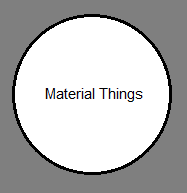
- To claim that nothing is immaterial is to say that the complement of the class of material things is empty, and to show that a class is empty you should shade the region of the diagram representing the class―see the diagram to the right. This shows that whatever exists is inside the class of material things, which is what materialists claim.
- "Not everything is an ivory-billed woodpecker" is the denial of the claim that everything is an ivory-billed woodpecker, that is, the claim that the complement class of ivory-billed woodpeckers is empty. To deny that a class is empty is to claim that there is something in it, which is diagrammed by placing an "X" in the region. In other words, "not everything is an ivory-billed woodpecker" is just another way of saying that some things are not ivory-billed woodpeckers, so you would diagram this statement the same way as you did the first exercise.
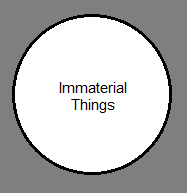
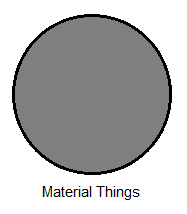
- If nothing is material then the class of material things is empty, so the circle for material things will be shaded as shown to the immediate right.
- If the circle represents the class of immaterial things, then the class of material things is its complement and would be shaded as shown in the second diagram to the right. Both of these diagrams represent the same thing, namely the philosophy of idealism, so don't let the fact that they look different fool you. When reading and understanding Venn diagrams, you need to pay careful attention to what classes the circles represent.
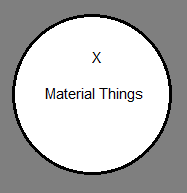
- To represent that the class of material things is non-empty, put an "X" inside the circle.
- These two philosophies cannot both be true, since idealism claims that the class of material things is empty (exercise 4), whereas materialism claims that it is not empty (exercise 6). In this kind of diagram it is forbidden to put both an "X" and shading in the same section, since these represent contradictory claims. This exercise gives just a glimpse at how this type of diagram can be used to reveal logical relationships between statements; we will see much more of this in the next lesson, when we add an additional circle. Stay tuned!
Solution to the Gang of Four Puzzle: Mr. Y killed Vic Timm.
Since we know that only one of the four gangsters shot Timm, and each of the four denies doing so, it follows that three of the denials are true and one is false. That means that only one of the remaining four statements is true, and the other three are false. Furthermore, since Mr. X and Mr. Z contradict each other about whether Mr. X owns a gun, one of these statements is true and one is false. This means that the remaining two statements by Mr. W and Mr. Y must be false. So, Mr. X didn't kill Timm and neither did Mr. W nor Mr. Z, which leaves only Mr. Y.
